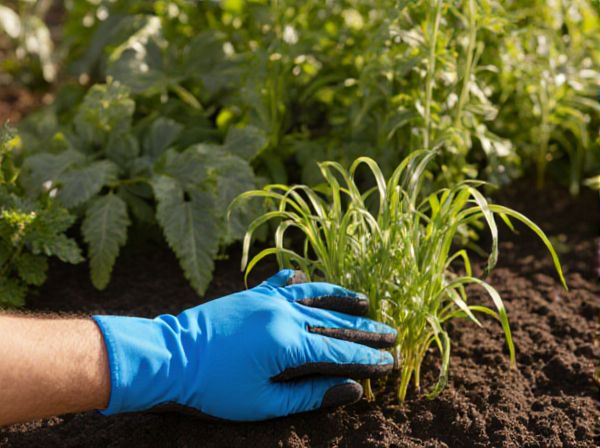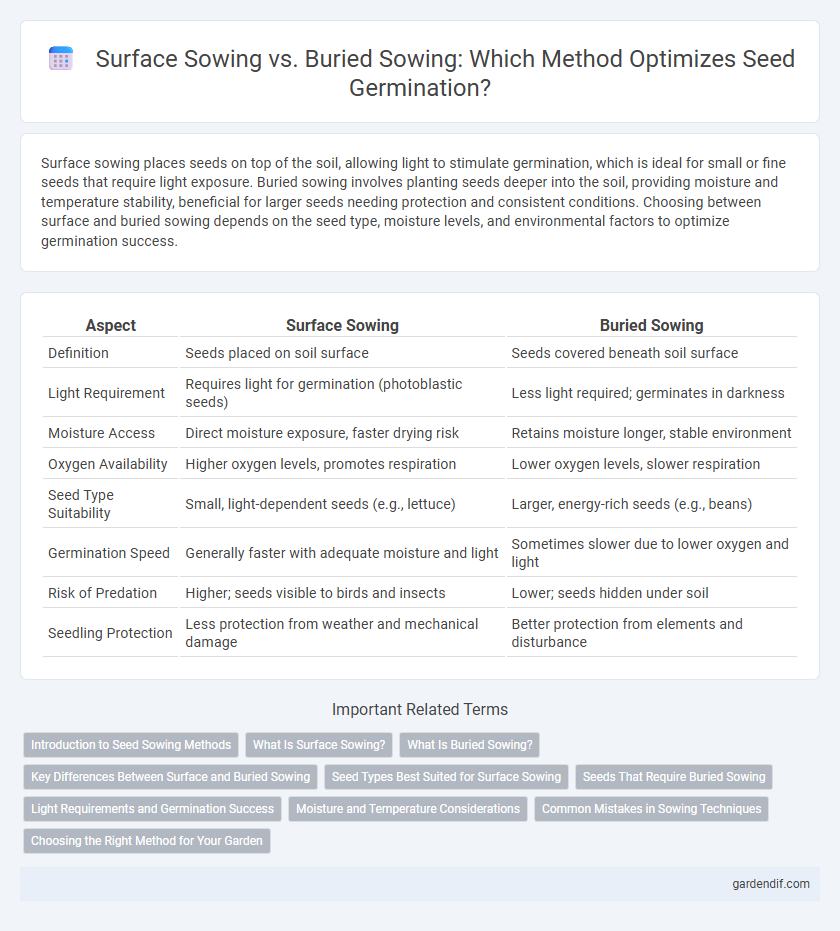
Surface sowing vs Buried sowing Illustration
Surface sowing places seeds on top of the soil, allowing light to stimulate germination, which is ideal for small or fine seeds that require light exposure. Buried sowing involves planting seeds deeper into the soil, providing moisture and temperature stability, beneficial for larger seeds needing protection and consistent conditions. Choosing between surface and buried sowing depends on the seed type, moisture levels, and environmental factors to optimize germination success.
Table of Comparison
| Aspect | Surface Sowing | Buried Sowing |
|---|---|---|
| Definition | Seeds placed on soil surface | Seeds covered beneath soil surface |
| Light Requirement | Requires light for germination (photoblastic seeds) | Less light required; germinates in darkness |
| Moisture Access | Direct moisture exposure, faster drying risk | Retains moisture longer, stable environment |
| Oxygen Availability | Higher oxygen levels, promotes respiration | Lower oxygen levels, slower respiration |
| Seed Type Suitability | Small, light-dependent seeds (e.g., lettuce) | Larger, energy-rich seeds (e.g., beans) |
| Germination Speed | Generally faster with adequate moisture and light | Sometimes slower due to lower oxygen and light |
| Risk of Predation | Higher; seeds visible to birds and insects | Lower; seeds hidden under soil |
| Seedling Protection | Less protection from weather and mechanical damage | Better protection from elements and disturbance |
Introduction to Seed Sowing Methods
Surface sowing involves placing seeds directly on the soil surface, ideal for small or light seeds requiring light for germination, while buried sowing places seeds below the soil to ensure moisture and temperature stability. Seeds sown on the surface often benefit from faster germination but face higher risks from drying out or predation. Buried sowing enhances seed-soil contact, improving moisture absorption and protection, which supports the successful emergence of larger or heavier seeds.
What Is Surface Sowing?
Surface sowing involves placing seeds directly on the soil surface without covering them with soil, allowing light and air to reach the seeds for optimal germination. This method suits seeds requiring light exposure to trigger sprouting, such as lettuce or parsley, and reduces the risk of rotting compared to buried sowing. Surface sowing promotes rapid and uniform seedling emergence when soil moisture and temperature conditions are adequately maintained.
What Is Buried Sowing?
Buried sowing involves placing seeds beneath the soil surface at a specific depth to ensure optimal moisture contact and protection from environmental stressors. This method improves seed germination rates by maintaining consistent temperature and moisture levels crucial for seed embryo development. Proper depth varies by seed type, with small seeds requiring shallower placement to avoid suffocation and larger seeds benefiting from deeper coverage to promote strong root growth.
Key Differences Between Surface and Buried Sowing
Surface sowing places seeds on the soil exterior, facilitating rapid oxygen access and quicker germination, especially for small or light-sensitive seeds. Buried sowing involves planting seeds deeper in the soil, providing moisture retention and protection but requiring more energy for seedlings to reach the surface. Key differences include oxygen availability, moisture exposure, light requirements, and seed depth, influencing germination rates and seedling vigor.
Seed Types Best Suited for Surface Sowing
Small, lightweight seeds such as lettuce, celery, and petunias are best suited for surface sowing because they require light for germination and can easily access oxygen. Surface sowing facilitates proper moisture levels and reduces the risk of damping-off, which is common in seeds buried too deeply. Seeds with fine or hairy coatings also perform well with surface sowing, as they can anchor lightly on the soil surface without being overshadowed or suffocated.
Seeds That Require Buried Sowing
Seeds that require buried sowing typically need consistent moisture and protection from environmental stressors to successfully germinate. Examples include carrots, parsnips, and beets, which have small seeds that benefit from soil coverage to maintain temperature and prevent drying out. Buried sowing also reduces predation by birds and insects, enhancing seedling survival rates.
Light Requirements and Germination Success
Surface sowing enhances germination success for light-dependent seeds by ensuring adequate exposure to sunlight, crucial for activating photoreceptors that trigger germination. Buried sowing suits seeds requiring darkness or minimal light, as soil coverage prevents light exposure, promoting moisture retention and consistent temperature vital for development. Optimizing sowing depth according to light requirements significantly improves germination rates and seedling vigor in diverse plant species.
Moisture and Temperature Considerations
Surface sowing requires consistent moisture on the soil surface and benefits from warmer temperatures to promote seed germination, as seeds remain exposed and depend on external conditions. Buried sowing provides stable moisture levels and a more regulated temperature environment, which can enhance germination rates for seeds sensitive to drying out or temperature fluctuations. Selecting between surface and buried sowing techniques depends on seed type and local climate conditions to optimize moisture retention and thermal requirements.
Common Mistakes in Sowing Techniques
Surface sowing often leads to poor seed-to-soil contact, resulting in uneven germination and increased susceptibility to drying out. Buried sowing mistakes include planting seeds too deep, which can prevent seedlings from emerging and waste seed resources. Proper seed depth and consistent moisture are crucial for optimizing germination rates and healthy seedling development.
Choosing the Right Method for Your Garden
Selecting the ideal sowing technique depends on seed type, soil conditions, and moisture levels; surface sowing works best for small, light seeds requiring light for germination, like lettuce or petunias. Buried sowing suits larger seeds or those needing dark, moist environments to sprout, such as beans or carrots, enhancing moisture retention and protection from birds. Proper method choice improves germination rates, seedling vigor, and ultimately leads to a successful, thriving garden.
Surface sowing vs Buried sowing Infographic

 gardendif.com
gardendif.com